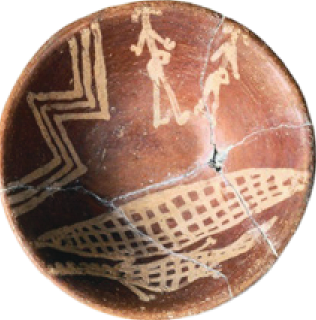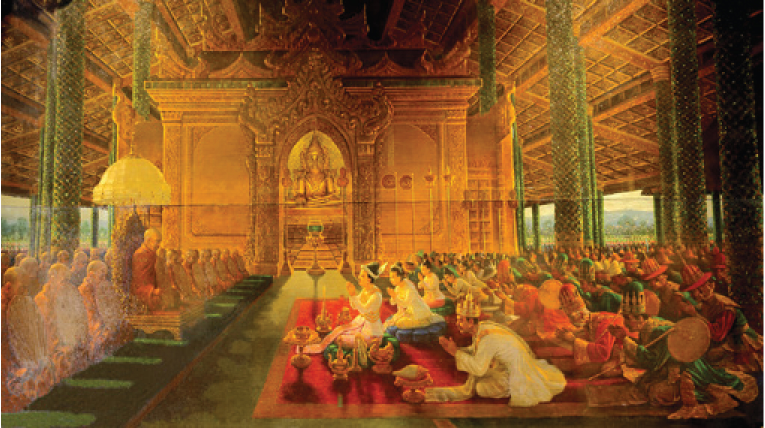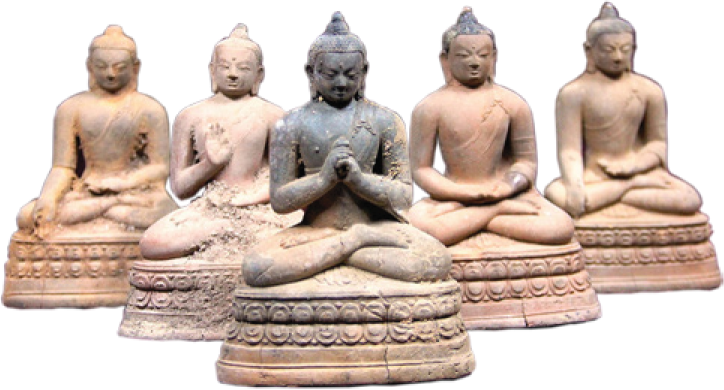HISTORY OF THE EAST. Universal history 
The prehistoric petroglyphs of large moisture-loving and semi-aquatic animals (such as elephants, giraffes, hippos, and crocodiles) in the wadis of the Egyptian Eastern Desert have been considered by some scholars of the past as one of the most important evidence, which supported the theory that the North African climates in the Antiquity were humid in comparison to that of the present day. Modern scholars, however, generally deny the actual existence of this fauna and interpret symbolically the rock-drawings found far away from the Nile. The author who has previously suggested that in the period between the 7th and the 4th millennium BC there was a huge lake situated between the present Asyut and Fayum, uses the petroglyphs found in the Eastern Desert as a source, which helps him to reconstruct the climate of the Egyptian Nile basin as well as some hydrological issues at the period of the mid-Holocene.
The article discusses one of the most paradoxical forms of embodying the image of the Buddha in Theravada iconography, which has been the subject of the scholarly discussions since the early age of the Buddhist Studies in the West. The author analyzes the main arguments, which support the theory of link between the emergence of crowned images and the Mahayana ideas, pointing to their inconsistency and weakness. He suggests a hypothesis about the existence in the Pali canon of fundamental sources, which generate the iconographic feature under research. As such he sees the concept of the mahapurisa (mahapurusha) and the dichotomy of the Paths of cakkavatti (cakravartin) and Buddha. He subsequently investigates the development of these concepts in the post-canonical Theravada literature. His special attention is paid to the Jambupati Sutta, text associated with the crowned Buddha image. He compares it to the canonical concept of cakkavatti. In the article is shown that this text, which traditionally was considered as apocryphal and of later date, in fact reflects the key ideas of the Canon and also has very early analogues. In the conclusion brought forward that the image of crowned Buddha reflects the idea of subordinating worldly power to the ultimate goal proclaimed by the Buddhist teachings. The image therefore has to be understood as a symbolic expression of the model of society, which provides the opportunity to follow the path leading to the liberation. This conclusion is illustrated by examples from the Royal ritual practices as well as “folk” forms of iconography.
This is another publication in the series of articles written by S-Kh, Syrtypova on the Buddhist iconography and the meaning of Buddhist deities in Mongolian Buddhism published in the Orientalistica earlier. This time the author deals with Ratnasambhava, Amitabha, Amoghasiddhi and Vairocana, the four of the Fife Tathagata Buddhas created by Zanabazar in 1683. The article comprises the history of their veneration, the specific details with regard to the spiritual of practices among Mongolian Buddhists and the visual representation of the deities by the famous artist Zanabazar. The sculpture of Ratnasambhava is preserved in the Museum-temple of Chiojin-lama, and others are preserved in the Zanabazar’s Museum of Fine Art in Ulaanbaatar city of Mongolia.
PHILOSOPHY OF THE EAST. Philosophy of religion and religious studies 
The article examines the fundamental revision of Aristotle’s “Metaphysics” engaged by the greatest Muslim philosopher Ibn Sina (Avicenna, 980-1037), in the first instance in the section under the title “Theology / Metaphysics” of his encyclopedic work “The Healing” (ash-shifᾱ’). On the basis of the treatise by Aristotle, which is in fact a conglomerate of fourteen different works, which do not constitute a coherent unity Avicenna produced a logical well rounded and systematic teaching. As a result of the synthesis of philosophy and religion, made by Avicenna the Aristotelian metaphysics became the ontotheology. The article consists of two parts. The first part highlights the basic attitudes of Ibn Sina's reform, especially epistemization of the philosophy and the application of the monotheistic approach. The second part which deals with the concept of the essence of metaphysics as viewed by Avicenna will be published in the following issue of the journal.
This is the final part of the translation into Russian of Ibn-Sina's treatise al-Isharat wa-t-Tanbihat (“Remarks and Admonitions”) by Abu Ali Ibn Sina (Avicenna 980-1037). Chapter 9 discusses the stages of the spiritual path for recognition of God -irfan (“gnosis”). Chapter 10 deals with miraculous signs and powers, which identify the 'arifs (“gnostics”).
The article deals with some specific features of Jain Tantrism, which make it different to the Hindu and Buddhist tantras. The author points to the secondary character of Jain Tantra in relation to other tantric traditions of India. She also emphasizes the fact that, despite the significant typological similarity with similar techniques and cults of other religions; the scope of use of tantric practices in Jainism is limited to purely secular purposes.
LITERATURE OF THE EAST. Literature of the peoples of foreign countries 
Many works by Muhammad Iqbal are in fact his appeal for social and spiritual changes within a society, which in his case was the Muslim community of British India. The word inqilᾱb (revolution) used in Iqbal’s poems became therefore one of the most visible markers to describe this kind of changes. At the beginning of the last century, the ideas regarding the revolutionary changes did find many sympathizers among the intellectual elite of the Indian Muslims. The Iqbal’s poetry offers sufficient evidence that the word inqilab as used in his writings covers three aspects, viz. temporal, social and religious. The semantics of the inqilᾱb fluctuates in accordance with the context in every given instance. The obvious change of meaning reflects the change of the poet's views in various stages of his literary production. The three dominant meanings of the concept inqilab can be identified as “changes”, “social revolution” (or lately the “national liberation movement”), and “the spiritual revolution of mind”. The article offers a discourse-cognitive analysis of the inqilᾱb concept in Iqbal’s poetry. In different periods of his work, this concept did correspond to different cognitive models, which were marked by the specific structure of presentation. The study includes textual, contextual and cognitive analysis of Iqbal’s poetic texts. The results of the study are presented in the form of frames.
LITERATURE OF THE EAST. Theory of literature. Textology 
The article examines the genesis and development of the medieval Mongolian poetic system. Mongolian literature of the Middle Ages developed within the Central Asian, Indo-Tibetan cultural context. Literary relations and contacts became especially active with the emergence and subsequent spread of Buddhism and its philosophy. Since the 17th century Ancient Indian Sanskrit poetry becomes a subject of increased attention. Treatises on poetry becomes to be translated, in particular, “Kavyadarsha” by Dandin, as well as Tibetan “debers”. The latter became instrumental for teaching and learning poetical styles, metres and versification systems. All this contributed to the formation and development of the Mongolian theory of poetry. Many poets and writers came from among the Mongolian learned monks. These people were familiar with the best examples of Indian and Tibetan literature as well as with the principles according to which they were constructed (poetics). Moreover, they themselves were authors of original works, which comprised learned comments on ancient Indian writings on aesthetics, philosophy and poetry, in such a way contributing to the further development of the theory of literature and flourishing of Mongolian poetry.
The personality of King David since the days of his reign has always been attracting the historians' and writers’ attention. Since the discovery of the Tel Dan inscription in 1993 there is little doubt about his physical existence. Nevertheless, while some scholars continue to consider him as a founder of the Empire (i.e. a united monarchy with the city of Jerusalem as its capital), some others still believe him to be an epic hero if not completely a folklore personage. The article deals with the information regarding King David as the first monarch of all Israelite tribes and his son King Solomon as his immediate successor on the throne. A comparison of the Biblical text with the archaeological data offers a conclusion that the phenomenon of the unified monarchy at that time was hardly identical to what was considered a unified monarchy in the 19th cent. Notwithstanding this fact, the personality of King David seems to be more realistic than that of King Solomon. In fact the description of the latter lacks exact and realistic features thus making this narrative a typical “golden age” saga of the bygone times.
In ancient anthropological views, the ability to stand upright was often regarded as a distinctively human ability given by the gods. Sometimes it was connected not only to the uprightness of the human body but also to that of the human soul, and indicated the human ability to contemplate one’s immortality. In the ancient Graeco-Roman literature this feature of the human soul was also connected with the restoration of physical life as a process of waking up from the sleep of death and was often represented by the verbs ἀνίστημι and ἐγέιρω. In biblical and cognate texts, these verbs represent the concept of resurrection. The present article discusses the link between the idea of physical uprightness and that of resurrection in ancient sources, especially the New Testament. In doing so, it applies some ideas of cognitive linguistics that help us to establish this link by means of the image-scheme UP-DOWN, which is used for creating the metaphor of resurrection as waking up and getting up from the sleep of death.
CHRONICLE. Reviews 
ISSN 2687-0738 (Online)
























